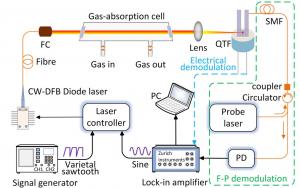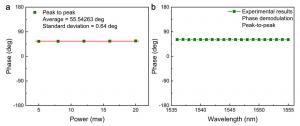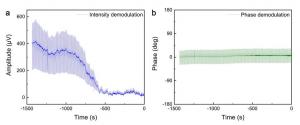Fabry–Perot-based phase demodulation of heterodyne light-induced thermoelastic spectroscopy

CW-DFB (continuous-wave distributed feedback); FC (fibre collimator); PD (photodetector); QTF (quartz tuning fork); SMF (single-mode fibre).
Trace gas sensors are used in different fields. Light-induced thermoelastic spectroscopy (LITES) has extremely high sensitivity and offers non-contact measurement, attracting extensive research attention. In general, the electrical signal amplitude increases linearly with an increase in laser power. However, thermal noise caused by laser irradiation in electrical signals magnifies exponentially as the laser power increases, restricting the signal-to-noise ratio (SNR) and minimum detection limit (MDL) of a LITES sensor. A potential solution is demodulating the vibration of the QTF in place of the electrical signal. Fabry–Perot (F–P) interferometer (FPI) are safe, remote, sensitive, anti-electromagnetic interference measurement devices for micro-vibration. For F–P micro-vibration sensors, the intensity demodulation method is typically used. Owing to ambient interference and disturbance of the laser wavelength, the signal becomes unstable.
In a new paper published in Light: Advanced Manufacturing, a team of scientists, led by Professor Yufei Ma from National Key Laboratory of Science and Technology on Tunable Laser, Department of Aerospace, Harbin Institute of Technology, China, and co-workers have developed a F–P-based phase demodulation of heterodyne LITES (H-LITES). The F–P cavity is comprised of an end-face of a single-mode fibre and a side of a prong of the QTF. When the QTF vibrates due to the effect of light-induced thermoelastic, the F–P cavity length varies; thus the phase changes. Because the vibration of the QTF is proportional to the gas concentration, the concentration can be inverted linearly by demodulating phase.
Compared to the H-LITES signal obtained directly from the electrical signal, the signal based on FPI had a greater SNR. The phase demodulation method can produce better detection performance, linear response, and long-term stability than the intensity demodulation method. Using the phase demodulation method, the signal peak-to-peak values are independent from power and wavelength. The phase demodulation method is immune to interference from the laser source and wavelength, and can resolve the issue of Q-point drifting due to ambient interference.
###
References
DOI
10.37188/lam.2023.023
Original Source URL
https://doi.org/10.37188/lam.2023.023
Funding information
This work was supported by the National Natural Science Foundation of China under Grant Nos. 62275065, 62022032, 61875047and 61505041; the Key Laboratory of Opto-Electronic Information Acquisition and Manipulation (Anhui University), the Ministry of Education (Grant No. OEIAM202202), and the Fundamental Research Funds for Central Universities.
About Light: Advanced Manufacturing
The Light: Advanced Manufacturing is a new, highly selective, open-access, and free of charge international sister journal of the Nature Journal Light: Science & Applications. It will primarily publish innovative research in all modern areas of preferred light-based manufacturing, including fundamental and applied research as well as industrial innovations.
Wendy Chen
TranSpread
+1 865-405-5638
email us here
Legal Disclaimer:
EIN Presswire provides this news content "as is" without warranty of any kind. We do not accept any responsibility or liability for the accuracy, content, images, videos, licenses, completeness, legality, or reliability of the information contained in this article. If you have any complaints or copyright issues related to this article, kindly contact the author above.


